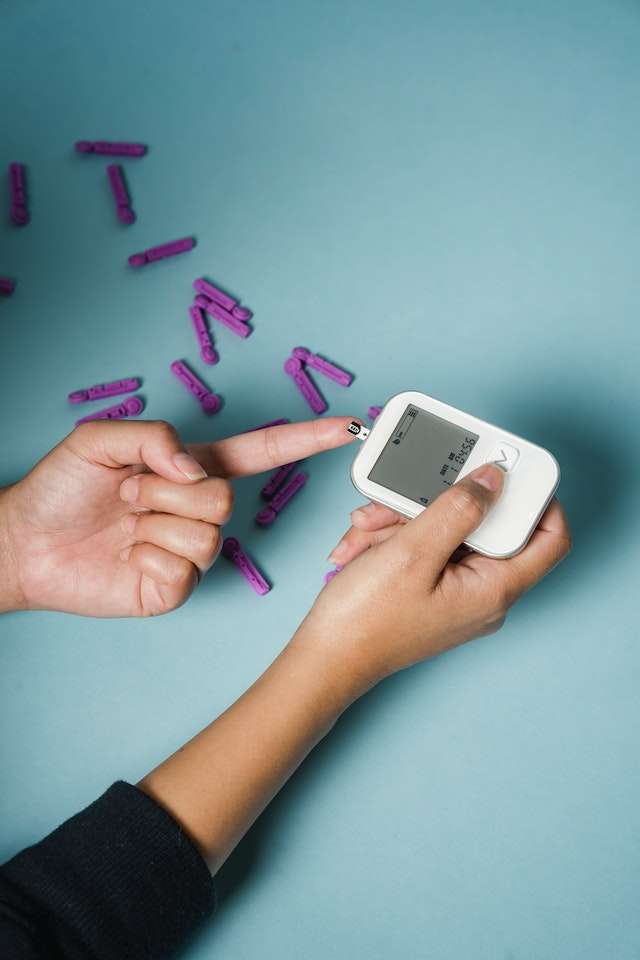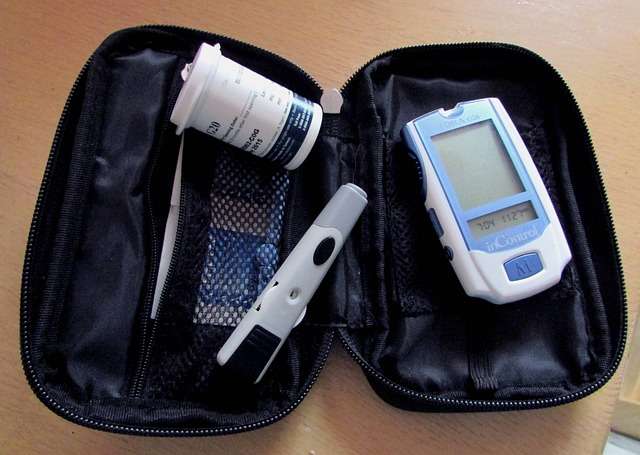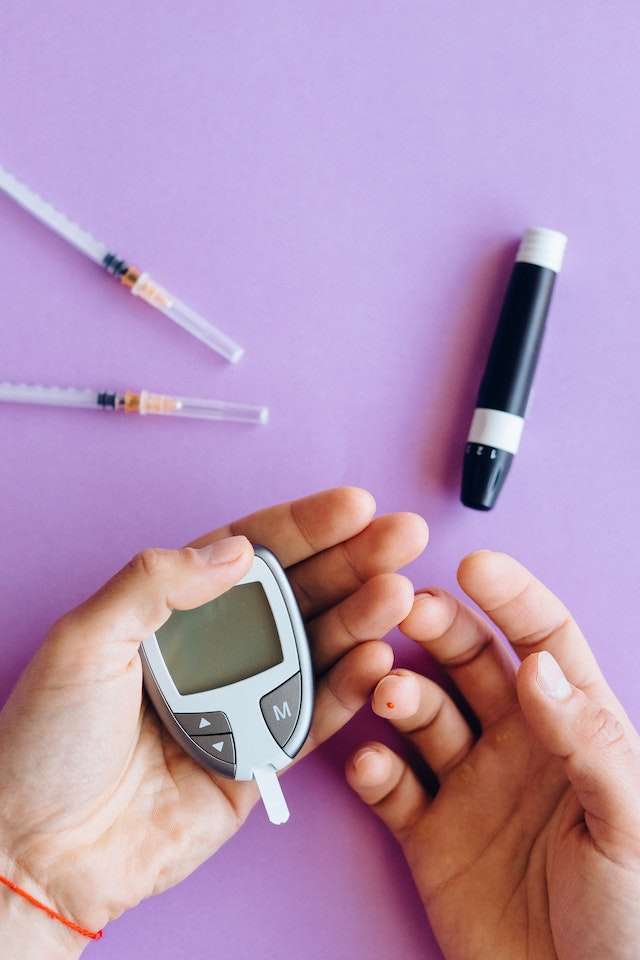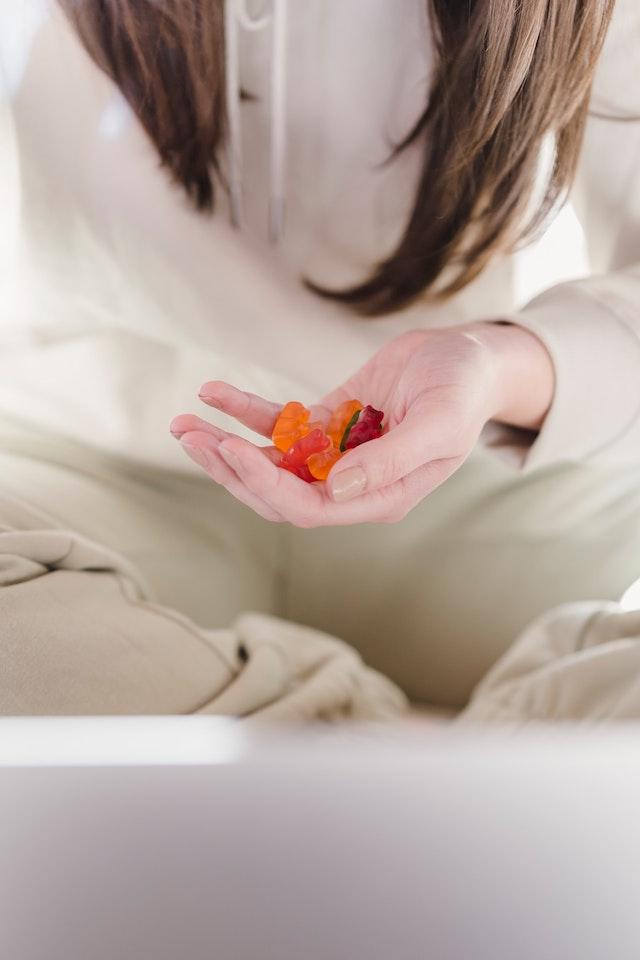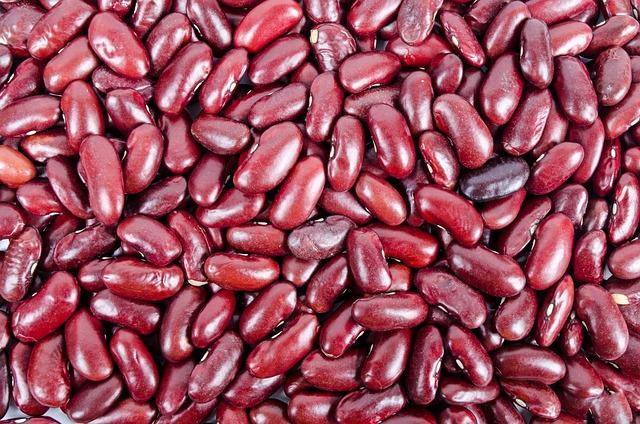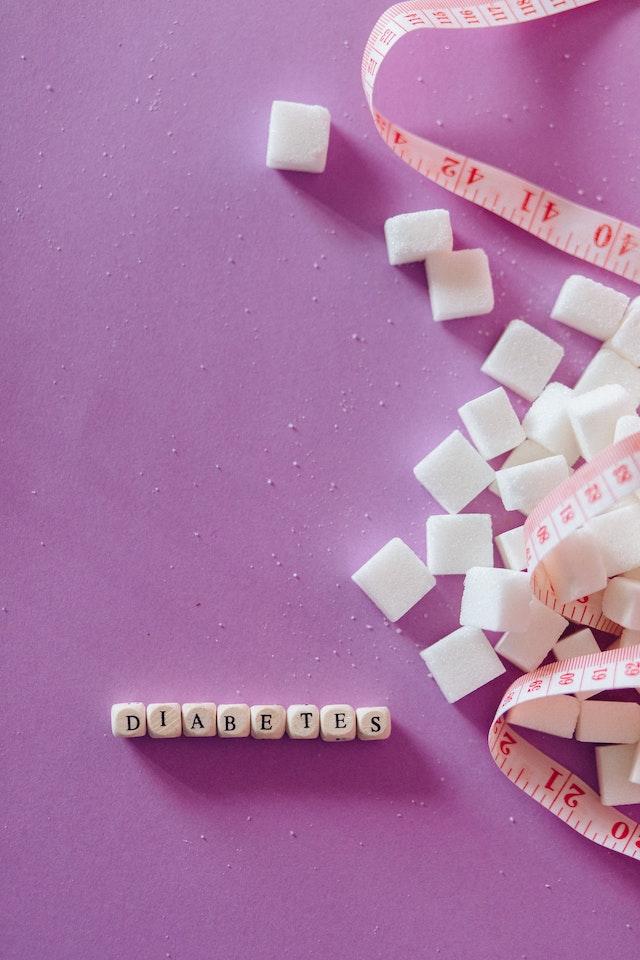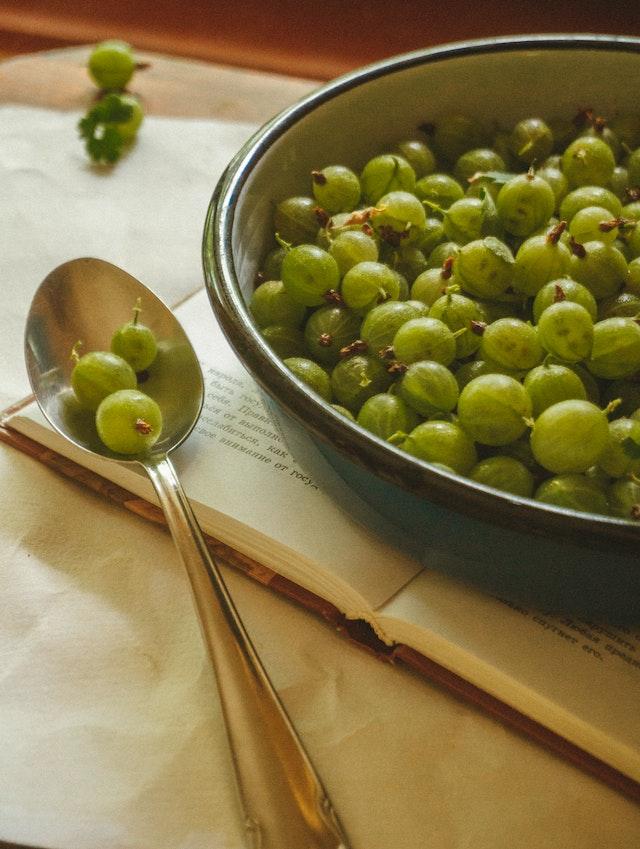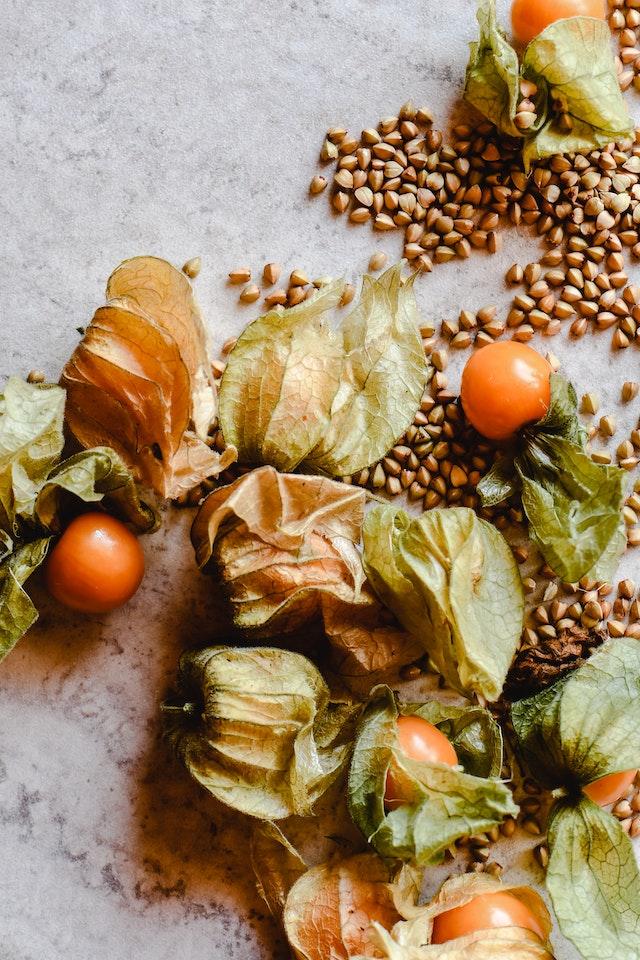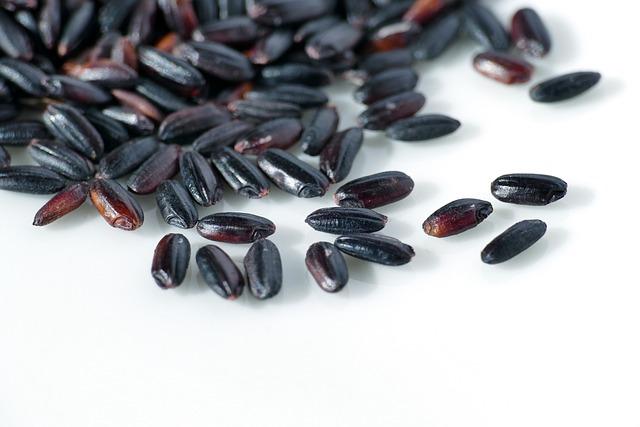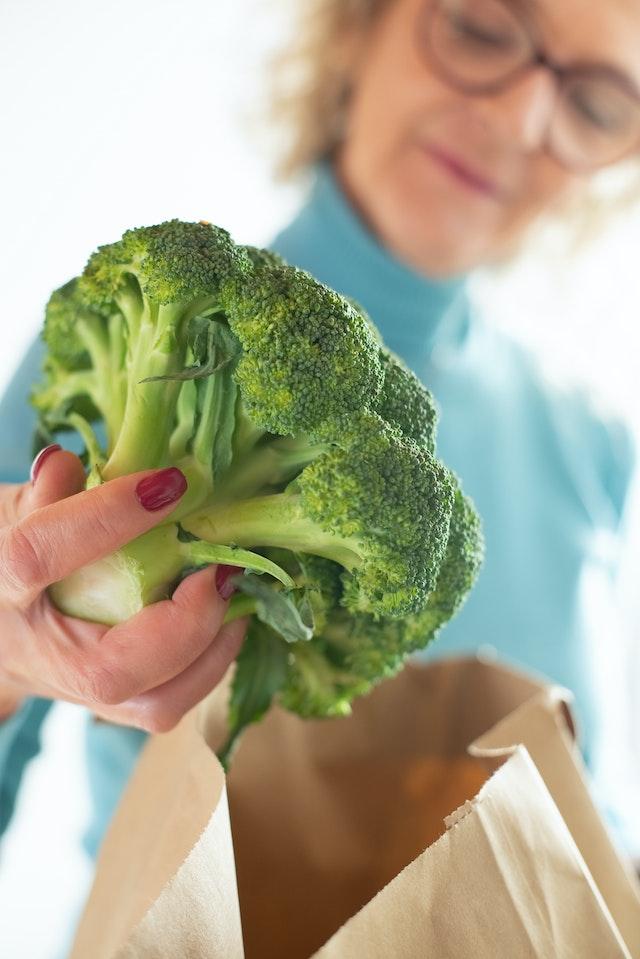Helps Against Diabetes

Can Vitamin B Prevent Peripheral Neuropathy Caused by Diabetes?
Peripheral neuropathy is a common complication of diabetes that affects the nervous system, causing debilitating symptoms such as pain, numbness, and tingling in the feet and hands. This condition is caused by high blood sugar levels that damage the nerves over time. If left untreated, this condition can lead to foot ulcers, infections, and even amputations.
Preventing peripheral neuropathy is crucial for individuals with diabetes, as it can greatly improve their quality of life. However, finding effective preventive measures can be challenging. Recently, studies have shown that vitamin B may be a potential solution.
Vitamin B is a group of water-soluble vitamins that play a crucial role in the nervous system’s function. Specifically, vitamin B1 (thiamine), vitamin B6 (pyridoxine), and vitamin B12 (cobalamin) have been studied for their potential neuroprotective effects in individuals with diabetes.
One study found that individuals with diabetes who supplemented with vitamin B12 for six months experienced improved nerve conduction and decreased symptoms of neuropathy. Another study found that taking a combination of vitamin B1, B6, and B12 supplements for six months led to significant improvements in neuropathy symptoms and nerve conduction.
While it is essential to get these vitamins from a balanced diet, some individuals with diabetes may not be able to absorb these vitamins correctly due to their condition’s effects on their digestive system. Thus, taking vitamin B supplements can help in maintaining adequate levels of these nutrients in the body.
Understanding Peripheral Neuropathy Caused by Diabetes
Peripheral neuropathy is a condition that affects the nerves that carry information to and from the brain, spinal cord and the rest of the body. It occurs when these nerves are damaged and is usually associated with diabetes. In this chapter, we will discuss the causes, symptoms, and risk factors of peripheral neuropathy in relation to diabetes.
What is Peripheral Neuropathy?
Peripheral neuropathy is a type of nerve damage that can result in pain, numbness, tingling, and weakness in the hands and feet. This condition commonly affects people with diabetes, and the risk of developing it increases if blood sugar levels are not well-controlled.
How does Diabetes cause Peripheral Neuropathy?
Diabetes is a disease that affects the way the body uses blood sugar (glucose). When the body is unable to produce insulin or use it properly, glucose levels in the blood become too high. Over time, high blood sugar levels can damage nerves, particularly those in the feet and legs, leading to peripheral neuropathy.
Symptoms of Peripheral Neuropathy
Peripheral neuropathy can cause a wide range of symptoms, depending on which nerves are affected. Some common symptoms of peripheral neuropathy caused by diabetes include:
- Tingling or burning sensation in the feet or hands
- Numbness or loss of sensation in the feet or hands
- Sharp or shooting pain in the feet or hands
- Muscle weakness or difficulty in moving the arms or legs
- Loss of balance or coordination
- Hypersensitivity to touch
The Role of Vitamin B in Preventing Peripheral Neuropathy
Vitamin B is a group of essential nutrients that play a vital role in maintaining overall health. Apart from providing energy and supporting the immune system, vitamin B has also been found to be effective in preventing peripheral neuropathy.
Research has shown that vitamin B can help prevent peripheral neuropathy by supporting nerve health and function. In particular, the B vitamins B1, B6, and B12 have been found to be particularly effective in reducing the risk of developing peripheral neuropathy.
- Vitamin B1, also known as thiamine, plays a critical role in the metabolism of glucose, which is the primary source of energy for nerve cells. When supply is inadequate, nerve cells can undergo oxidative stress, leading to inflammation, and damage to the nerves. Vitamin B1 has been found to protect nerve cells from oxidative stress and inflammation, thus preventing peripheral neuropathy.
- Vitamin B6, also known as pyridoxine, is essential in the formation of myelin, which is the protective covering that surrounds nerve cells. Myelin acts as insulation, allowing nerve signals to transmit faster and more efficiently. A deficiency in vitamin B6 can lead to nerve damage and a disease called neuropathy.
- Vitamin B12, also known as cobalamin, is crucial in the metabolism of nucleic acids and fatty acids, which are necessary for the formation and maintenance of nerve cells. Furthermore, vitamin B12 is responsible for the production of myelin. A deficiency in vitamin B12 can lead to nerve damage and peripheral neuropathy.
Studies that Support the Use of Vitamin B for Preventing Peripheral Neuropathy
Research has shown that vitamins B1, B6, and B12 can play a critical role in preventing peripheral neuropathy. These vitamins work together to strengthen the nerves, reduce inflammation, and improve nerve function, helping to prevent nerve damage.
In a study published in the Journal of Diabetes and Its Complications, researchers found that taking 600 mg of Alpha-Lipoic Acid and 400 mg of vitamin B complex daily for 24 weeks significantly reduced neuropathic symptoms in people with type 2 diabetes.
Similarly, a meta-analysis of five clinical trials found that taking vitamin B complex supplements reduced diabetic neuropathy and improved nerve function in people with type 2 diabetes. These findings suggest that incorporating vitamin B into one’s diet can help manage peripheral neuropathy, especially for those with diabetes.
The Limitations of Current Research
While the role of vitamin B in preventing peripheral neuropathy is promising, current research does have its limitations. For example, most studies are small and only focus on specific types of neuropathy, such as diabetic neuropathy. Additionally, the optimal dosage and duration of vitamin B supplementation are not yet known. More research is needed to determine the best way to incorporate vitamin B into one’s diet for maximum benefits.
Furthermore, it’s important to note that vitamin B supplements can interact with other medications, potentially causing adverse reactions. Therefore, it’s important to discuss the use of vitamin B supplements with a healthcare professional before taking them.
Supplementing with Vitamin B for Prevention
Vitamin B is a crucial nutrient that our body needs to function efficiently. It is responsible for fueling our bodies with energy, keeping our brain healthy, and producing red blood cells. Unfortunately, not everyone gets enough vitamin B in their diet, which can lead to several health problems. This is why supplementing with vitamin B can be a game-changer, especially if you are at risk of a deficiency. Here, we’ve put together essential information on how to incorporate vitamin B into your diet, recommended daily amounts, and when to consider taking supplements.
How to Incorporate Vitamin B into Your Diet
The best way to get vitamin B is through a balanced diet that includes a variety of foods. Vitamin B can be found in many foods, including:
- Whole grains like rice, oats, and barley
- Meat and fish, including chicken, turkey, tuna, and salmon
- Dark, leafy vegetables like spinach, kale, and broccoli
- Dairy products like milk and yogurt
- Legumes like beans and lentils
A healthy diet that includes a combination of these foods might provide adequate levels of vitamin B for most people. However, those with dietary restrictions, such as vegetarians and vegans, may struggle to get enough vitamin B from food alone.
Recommended Daily Amounts
The recommended daily amount of vitamin B varies depending on factors such as age, sex, and other health conditions.
Generally, the recommended daily amounts for adults are:
- Vitamin B1 (Thiamine): 1.2 mg per day for men and 1.1 mg per day for women
- Vitamin B2 (Riboflavin): 1.3 mg per day for men and 1.1 mg per day for women
- Vitamin B3 (Niacin): 16 mg per day for men and 14 mg per day for women
- Vitamin B5 (Pantothenic Acid): 5 mg per day for both men and women
- Vitamin B6 (Pyridoxine): 1.7 mg per day for men and 1.5 mg per day for women
- Vitamin B7 (Biotin): 30 mcg per day for both men and women
- Vitamin B9 (Folate): 400 mcg per day for both men and women
- Vitamin B12 (Cobalamin): 2.4 mcg per day for both men and women
When to Consider Taking Vitamin B Supplements
For most people, a healthy diet provides enough vitamin B to avoid a deficiency. However, some people may need to take supplements to meet their daily requirements. These include:
- Pregnant or breastfeeding women: These individuals may need more vitamin B than usual to support their and their baby’s health.
- People on medication: Certain medications can deplete vitamin B levels in the body, making supplements necessary.
- People with medical conditions: Diseases like celiac disease and Crohn’s disease can interfere with the body’s ability to absorb nutrients, making supplementation necessary.
If you are considering taking vitamin B supplements, it’s essential to talk to your doctor first. Some vitamin B supplements can interfere with medication or cause side effects, such as nausea or dizziness.
Other Ways to Prevent Peripheral Neuropathy
In addition to Vitamin B, there are several other ways to prevent peripheral neuropathy, which we will discuss in this chapter.
- Managing Blood Sugar Levels
One of the most important ways to prevent peripheral neuropathy is to manage your blood sugar levels. High blood sugar can damage the nerves in your feet and legs, leading to symptoms of neuropathy. If you have diabetes, it is especially important to keep your blood sugar levels under control. This can be achieved by monitoring your blood sugar levels regularly, taking medications as prescribed by your doctor, and eating a healthy diet.
- Exercising Regularly
Regular exercise can also help prevent peripheral neuropathy. Exercise improves blood flow to your feet and legs, which can help prevent nerve damage. Exercise also helps reduce inflammation and improve nerve function, which can help prevent neuropathy symptoms. You should aim to exercise for at least 30 minutes a day, five days a week. Consult your healthcare provider before starting any exercise program.
- Maintaining a Healthy Diet and Lifestyle
Maintaining a healthy diet and lifestyle is also important for preventing peripheral neuropathy. You should avoid smoking and limit your alcohol consumption, which can both damage nerves. You should also eat a diet rich in fruits, vegetables, and whole grains, as these foods contain essential vitamins and minerals that support nerve health. Additionally, you should aim to maintain a healthy weight, as being overweight or obese can increase your risk of developing neuropathy.
Conclusion
Peripheral neuropathy caused by diabetes is a painful and debilitating condition. However, by taking the right steps to keep blood sugar levels regulated, the risk of nerve damage can be reduced. Vitamin B supplementation is one such step that could be taken to help prevent nerve damage and reduce the effects of existing nerve damage caused by diabetes. Taking b-complex, thiamine B1, B6, and B12 can be especially beneficial for maintaining nerve health, which could help decrease the risk and severity of peripheral neuropathy caused by diabetes.
FAQ
How does Vitamin B help in preventing Peripheral Neuropathy caused by Diabetes?
- Vitamin B12 plays an essential role in the maintenance and repair of the nerves’ myelin sheath. Myelin sheaths are essential for the proper functioning of the nerves.
How much Vitamin B should I take to prevent Peripheral Neuropathy caused by Diabetes?
- The recommended daily dosage of Vitamin B12 for adults is 2.4 mcg. It is best to consult with your doctor, who can suggest the appropriate dosage based on your individual needs.
Can taking too much Vitamin B cause any adverse effects?
- Taking excessive amounts of Vitamin B can lead to mild side effects such as diarrhea, itching, or rash. It is essential to follow the recommended dosage as prescribed by your doctor.
Can Vitamin B prevent Peripheral Neuropathy caused by conditions other than Diabetes?
- Yes, Vitamin B is beneficial in preventing Peripheral Neuropathy caused by various medical conditions and nervous system disorders. However, it is essential to consult with your doctor before consuming any supplements.
Are there any other benefits of consuming Vitamin B?
- Vitamin B plays a crucial role in maintaining a healthy nervous system, promoting red blood cell formation, and supporting the proper functioning of the brain.
What are the food sources of Vitamin B?
- Natural food sources of Vitamin B include fish, shellfish, poultry, meat, eggs, and dairy products. Vegetarians and vegans can consume nutritional yeast, fortified cereals, and plant-based milk.
Can I combine Vitamin B with other supplements or medication?
- It is crucial to consult with your doctor or pharmacist before combining Vitamin B with any other supplements or medication. Certain medications can interact with Vitamin B supplements, leading to adverse effects.
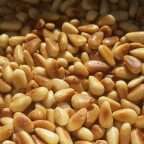
Do Pine Nuts Lower Blood Sugar?
Many people around the world are struggling with medical conditions related to high blood sugar levels, such as diabetes. As a result, a growing number of studies have focused on the role that certain foods and nutrients play in regulating blood sugar levels.
Pine nuts are one such food that has gained interest and attention for its potential to lower blood sugar levels. In this article, we will look at the link between pine nuts and blood sugar levels, examine the existing research on the topic, and provide insights into incorporating pine nuts into a healthy diet.
Understanding Blood Sugar Levels and Its Importance in the Body
Blood sugar, also known as glucose, is a type of sugar that travels through the bloodstream to provide energy to the body’s cells. It is an essential source of fuel for all the body’s functions, including the brain, muscles, and organs.
Why is Blood Sugar Important?
The body tightly regulates blood sugar levels, ensuring that they remain within specific ranges. The reason for this is that too much or too little blood sugar can lead to serious health complications.
When blood sugar levels are too high, it can lead to hyperglycemia, which is a condition that can damage vital organs like the brain and kidneys. At the same time, when blood sugar levels are too low, it can cause hypoglycemia, leading to lightheadedness, seizures, and even unconsciousness.
Blood sugar levels are an essential component of overall health and wellbeing. Understanding how the body’s regulation mechanisms work can help individuals make informed lifestyle choices that support healthy blood sugar levels.
Consultation with healthcare professionals can also play a crucial role in preventing and managing conditions related to blood sugar levels.
What are Pine Nuts?
If you’ve ever enjoyed a pesto sauce or a nutty granola, then chances are you’ve tasted pine nuts. But what exactly are they?
Pine nuts, also known as pignoli, are the edible seeds harvested from pine trees. They’re usually found inside the cones of different species of pine trees, including the stone pine, Korean pine, and piñon pine.
These small, ivory-colored nuts pack a lot of flavor and nutrition into a tiny package.
Let’s explore details about these nuts:
Nutrition
- Pine nuts are a good source of healthy fats, protein, and fiber. They also contain vitamins and minerals like zinc, magnesium, and vitamin E.
- Studies have shown that consuming pine nuts (and other nuts) can reduce the risk of heart disease and lower cholesterol levels.
- Pine nuts are also a low-glycemic-index food, meaning they don’t cause a rapid rise in blood sugar levels. This makes them a good snack option for people with diabetes.
Flavor
- Pine nuts have a rich, buttery flavor with a slightly sweet and nutty taste.
- They have a delicate texture that’s similar to sunflower seeds or almonds.
- Pine nuts are often used in Mediterranean cuisine, especially in dishes like pesto sauce, salads, and baked goods.
Harvesting and Processing
- Pine nuts are generally harvested by hand because the cones need to be opened to access the seeds inside.
- Harvesting and processing pine nuts can be a time-consuming and labor-intensive process, which is why they tend to be more expensive than other types of nuts.
- Once harvested, pine nuts need to be shelled to remove the hard outer shell before they can be eaten.
Uses
- Pine nuts are a versatile ingredient that can be used in many different types of dishes, from savory to sweet.
- They’re a popular ingredient in Mediterranean and Middle Eastern cuisine, but can also be found in dishes from around the world.
- Some popular uses for pine nuts include as a topping for salads, roasted or baked in savory dishes, or blended into desserts like cakes and cookies.
How do Pine Nuts Affect Blood Sugar Levels?
- Several studies have been conducted to explore the link between pine nuts and blood sugar levels. One small study published in the Journal of the Science of Food and Agriculture found that consuming pine nuts with high-carbohydrate meals resulted in lower postprandial blood sugar levels compared to meals without pine nuts.
- Another study conducted by the University of Sydney found that consuming pine nuts as part of a low-glycemic index (GI) diet resulted in lower fasting blood sugar levels compared to a high-GI diet without pine nuts.
- The specific mechanisms by which pine nuts impact blood sugar levels are not yet fully understood. However, it is believed that the fiber, healthy fats, and minerals in pine nuts may play a role in regulating blood sugar levels. For example, the fiber in pine nuts can slow down the absorption of glucose into the bloodstream, reducing the likelihood of spikes in blood sugar levels after meals.
The Active Compounds in Pine Nuts That Affect Blood Sugar Levels
Pine nuts have long been a favorite snack in many cultures. These tiny, creamy-white nuts have a unique flavor and offer a range of health benefits. But did you know that they also contain active compounds that affect blood sugar levels? In this chapter, we will explore these compounds and how they work.
Phytosterols
- Phytosterols are compounds found in plant foods that have a similar chemical structure to cholesterol. However, unlike cholesterol, phytosterols can help reduce cholesterol levels in the body. This is because they block the absorption of cholesterol in the intestines. Pine nuts contain high levels of phytosterols, which can help reduce cholesterol levels and improve overall heart health.
Pinolenic Acid
- Pinolenic acid is a type of fatty acid found only in pine nuts. This fatty acid has been found to have a significant impact on blood sugar levels. Research has shown that pinolenic acid can increase the production of GLP-1, a hormone that helps regulate blood sugar levels. This means that pine nuts may be beneficial for people with diabetes or those at risk of developing it.
Polyphenols
- Polyphenols are a group of compounds found in many plant-based foods, including pine nuts. These compounds have been found to improve insulin sensitivity, which can help regulate blood sugar levels. Polyphenols also have antioxidant properties that can help reduce inflammation and protect against chronic diseases such as heart disease and cancer.
Fiber
- Fiber is an essential nutrient found in plant-based foods, including pine nuts. Fiber is important for overall health, but it also plays a crucial role in regulating blood sugar levels. This is because fiber slows down the absorption of glucose into the bloodstream, preventing blood sugar spikes.
- Pine nuts contain both soluble and insoluble fiber, making them an excellent choice for maintaining healthy blood sugar levels.
The Benefits of Pine Nuts for People with Diabetes
Diabetes is a chronic medical condition that affects millions of people worldwide. It is characterized by high blood sugar levels, which can lead to several health problems. Pine nuts, however, have been found to provide numerous benefits to people with diabetes. Here are the top benefits of pine nuts for people with diabetes:
1. Lowering Blood Sugar Levels
One of the primary benefits of pine nuts for people with diabetes is their ability to lower blood sugar levels. They contain a high amount of magnesium, which helps improve insulin sensitivity and regulate blood sugar levels.
Pine nuts also have a low glycemic index (GI), which means they are slowly absorbed into the bloodstream, causing a gradual rise in blood sugar levels rather than an abrupt spike.
2. Reducing the Risk of Heart Disease
Heart disease is a common complication of diabetes, and people with diabetes are at an increased risk of developing heart disease. However, incorporating pine nuts into your diet can help reduce this risk.
Pine nuts are a rich source of monounsaturated and polyunsaturated fats, both of which are beneficial for heart health. They also contain phytosterols, which have been found to lower cholesterol levels.
3. Decreasing Inflammation
People with diabetes are prone to chronic inflammation, which can lead to various complications. Pine nuts have anti-inflammatory properties and contain a high amount of vitamin E, which is a powerful antioxidant. Vitamin E helps protect cells from damage caused by free radicals, which can cause inflammation.
Pine nuts offer significant benefits for people with diabetes. They can help regulate blood sugar levels, reduce the risk of heart disease, and decrease inflammation. Adding pine nuts to your diet is an excellent way to incorporate a nutritious and delicious food that can help manage your diabetes and improve your overall health.
Other Health Benefits of Pine Nuts
In addition to potentially lowering blood sugar levels, pine nuts have several other health benefits. As previously mentioned, pine nuts are a rich source of healthy fats, including polyunsaturated and monounsaturated fats. These fats have been shown to improve heart health by reducing inflammation and lowering cholesterol levels. Additionally, pine nuts are a great source of protein, an essential nutrient that is important for building and repairing tissues in the body.
Incorporating Pine Nuts Into a Healthy Diet
If you are interested in incorporating pine nuts into your diet for their potential blood sugar-lowering effects, there are several delicious and nutritious ways to do so. Pine nuts can be added to salads, sprinkled over roasted vegetables or used as a tasty topping for oatmeal or yogurt. Additionally, pine nuts can be blended into pestos or used as a nut butter substitute in recipes for a more savory flavor profile.
Conclusion
While more research is needed to fully understand the link between pine nuts and blood sugar levels, preliminary studies suggest that consuming pine nuts may have a positive impact on blood sugar regulation.
Additionally, pine nuts have numerous other health benefits, such as being a good source of healthy fats and protein. Incorporating pine nuts into a healthy diet is an easy and delicious way to boost your overall health and potentially lower your risk of conditions such as type 2 diabetes.
FAQ
How do pine nuts lower blood sugar?
Pine nuts contain certain nutrients that help regulate blood sugar levels. They contain magnesium, which has been shown to improve insulin sensitivity and lower blood sugar levels in people with type 2 diabetes.
Are pine nuts effective in lowering blood sugar in the long term?
Pine nuts are not a magic solution, but can be an effective part of a balanced diet and exercise routine in maintaining healthy blood sugar levels in the long term.
How many pine nuts should I eat to see the benefits?
There is no set number of pine nuts that need to be consumed to see the benefits of blood sugar regulation. However, consuming a handful of pine nuts on a regular basis can be helpful.
Are pine nuts safe for people with diabetes to consume?
Yes, pine nuts are generally safe for people with diabetes to consume. However, it is recommended that individuals with diabetes follow a balanced diet and consult with their healthcare provider before adding pine nuts to their diet.
Can pine nuts be substituted for diabetes medication?
No, pine nuts cannot be substituted for diabetes medication. They can be consumed as a supplement to medication and a healthy diet and exercise routine.
Are there potential side effects of consuming pine nuts for blood sugar control?
Pine nuts are generally safe for consumption, but can cause allergic reactions in some individuals. It is recommended to consult with a healthcare provider before introducing pine nuts to a diet.
Can pine nuts be consumed raw or do they need to be cooked?
Pine nuts can be consumed raw or cooked. They are commonly used in salads or added to dishes as a garnish.
Where can I find pine nuts to incorporate into my diet?
Pine nuts are commonly found online, in health food stores or grocery stores in the nut section. They can be added to salads, granolas, or eaten as a snack.
Can pine nuts be used to prevent the onset of diabetes?
While pine nuts can be an effective part of a balanced diet and exercise routine to maintain healthy blood sugar levels, there is no known cure or prevention for diabetes. It is important to maintain a healthy lifestyle and consult with a healthcare provider for diabetes prevention advice.
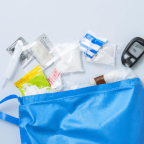
Why a Diabetes Supplies Bag is a Game-Changer for Managing your Health
As a person living with diabetes, one of the biggest challenges you face every day is the need to stay organized and ensure that you have all the necessary supplies at hand. This is where a diabetes supplies bag can prove to be a true game-changer in helping you manage your health effectively. In this article, we will discuss why a diabetes supplies bag is essential and how it can help you take control of your diabetes.
Firstly, let’s understand what a diabetes supplies bag is. Simply put, it is a bag or a pouch that contains all the essential supplies that people with diabetes need to manage their condition on a daily basis. These supplies may include insulin pens, glucose meters, test strips, lancets, alcohol swabs, glucagon kits, and even snacks for managing low blood sugar.
Now, you may be wondering why you need a separate bag when you can easily carry all these items in your regular bag or pockets. The answer is simple – organization and convenience.
When you have a dedicated diabetes supplies bag, you can keep all your supplies together in a neat and organized manner. This ensures that you don’t waste time and energy hunting for individual items when you need them the most. Additionally, a dedicated bag reduces the risk of losing or misplacing your supplies, which can be disastrous for your health.
Moreover, a diabetes supplies bag provides convenience and peace of mind. When you leave your house or travel, you can easily grab your bag containing all your supplies and medications. This reduces the chances of leaving behind important items and running the risk of an emergency.
Benefits of a Diabetes Supplies Bag
Let’s now talk about the benefits of a diabetes supplies bag.
1. Reduces stress and anxiety
Living with diabetes can be stressful and overwhelming, especially when you have to constantly track your blood sugar levels and manage your medications. A diabetes supplies bag helps you stay organized and keeps all your supplies in one place. This reduces stress and anxiety and helps you focus on your health goals.
2. Helps you maintain healthy habits
A diabetes supplies bag contains all the necessary supplies you need to monitor your blood sugar levels and manage your medications. This helps you maintain healthy habits and ensures that you don’t miss any crucial doses or readings.
3. Increases independence and confidence
A diabetes supplies bag empowers you to take control of your health and increases your independence and confidence. With all your supplies in one place, you don’t have to rely on others to manage your medications or supplies.
4. Facilitates better communication with healthcare providers
A diabetes supplies bag makes it easy to communicate with your healthcare providers. You can easily take your bag containing all your supplies and medications to your appointments, which helps your healthcare provider get a better understanding of your condition and evaluate your progress.
5. Saves time and energy
A diabetes supplies bag saves time and energy by keeping all your supplies organized and readily accessible. This eliminates the need to rummage through different bags or pockets to find individual items, which can waste valuable time and energy.
6. Helps you avoid emergencies
A diabetes supplies bag equipped with emergency supplies can help you avoid emergencies. You can include items such as a glucagon kit and snacks to manage low blood sugar. Having these items readily available can help you avoid potentially dangerous situations.
Tips for Choosing the Right Bag
Now that you understand the benefits of a diabetes supplies bag, let’s talk about some tips for choosing the right bag.
1. Look for a bag that is spacious and organized
Choose a bag that has enough compartments and pockets to keep all your supplies organized. This reduces the risk of misplacing important items and helps you find what you need quickly.
2. Choose a bag that is easy to carry and visually appealing
Look for a bag that is easy to carry and visually appealing. You want a bag that you’re comfortable carrying around and that makes you feel good about yourself.
3. Choose a bag that is durable and easy to clean
Essential Items to Keep in a Diabetes Supplies Bag
Living with diabetes means that it’s important to always be prepared for any related medical emergencies. A key element of this is having a diabetes supplies bag with all the essential items you need to stay safe and healthy.
Here are some common items to keep in your Diabetes Supplies Bag:
1. Insulin
- Insulin is a hormone that helps the body regulate glucose, or blood sugar. Insulin dosage is often managed with a pump, a device that injects insulin into the body as it monitors glucose levels. A diabetes supplies bag should contain different dosages of insulin for pumps, and a syringe for manually injecting insulin, in case of emergencies.
2. Glucose Tablets
- In cases of a sudden drop in blood sugar level, glucose tablets are a must-have in diabetes supplies bags. They are small, easy to carry and can be quickly ingested for an instant boost of energy.
3. Ketone Strips
- Ketone strips are used to measure ketone levels in the body, providing useful information about a person’s diabetes management. A diabetes supplies kit should contain test strips designed to measure ketone levels.
4. Hypo Treatment
- Hypo treatments are snacks or drinks used to quickly raise a person’s blood sugar levels. A diabetes supplies kit should always have hypo treatments that are easy to carry and quick to consume, such as juice or chocolate.
5. Glucose Meter
- Glucose meters measure the amount of glucose present in the blood and allow people to keep close track of their glucose levels. The meter should be included in the diabetes supplies bag in case the person needs to reference their levels away from home.
6. Medical Identification
- People living with diabetes should always carry some type of medical identification on them. A diabetic supplies bag should contain an ID card, bracelet or necklace that indicates the person is diabetic, in case of emergency.
7. Insulin Pen Needles
- Insulin pen needles are critical to managing a diabetes supplies bag. The needles should be kept in the bag and replaced at least once a month.
8. Sharps Container
- The sharps container is a thick, puncture resistant container used to safely store used insulin pens, needles and syringes. The insulin supplies bag should always include a sharps container to store discarded materials.
9. Glucose Gels
- Glucose gel is a type of hypo treatment sold in tubes or single-serve sachets that can be quickly ingested if a person is experiencing a hypoglycemic attack. The gel should be included in the diabetes supplies bag in case of emergency.
10. Syringes
- Syringes are often used in place of insulin pens, and may be required to administer insulin manually. The diabetes supplies bag should contain at least one or two syringes in case the person needs to inject insulin manually.
11. Other Considerations
- In addition to the items listed above, diabetes supplies bags should also include any additional items a person with diabetes may need. These can include rubber gloves, alcohol pads, glucagon kits, insulin vials and sterile water. Any other items that are recommended by a doctor should also be included in the diabetes supplies bag.
Conclusion
Living with diabetes means it is essential to always be prepared for the unexpected. By having a diabetes supplies bag and keeping it stocked with all the essential items a person needs to manage their condition, they can feel safer and more confident in their health. This comprehensive guide can help you make sure your diabetes supplies bag is well stocked and ready to go!
Choose a bag that is durable and easy to clean. A diabetes supplies bag is likely to be used frequently and may come into contact with spills and other contaminants. A durable and easy-to-clean bag will ensure that your supplies remain safe and hygienic.
By choosing the right bag, you can take control of your health and live with confidence and independence.

Erythritol, a Common Sweetener, Linked to Potential Heart Attacks
Introduction
This article explores the latest study on erythritol, a low-calorie sweetener, and its potential benefits and drawbacks for cardiovascular health.
Unlike other sugar alcohols, such as sorbitol and xylitol, erythritol doesn’t cause digestive issues in most people because it is absorbed into the bloodstream before reaching the large intestine.
This property, along with its low calorie count, has made erythritol a popular alternative to sugar, especially among people with diabetes or those who are trying to lose weight.
However, there have been concerns about its effects on the heart. Some studies have suggested that erythritol may increase the risk of heart attacks.
In this article, we will explore the link between erythritol and heart attacks and determine whether this is a cause for concern.
How is Erythritol Produced?
Erythritol is produced by fermenting glucose with a yeast called Moniliella pollinis. The yeast converts the glucose into erythritol through a process called reduction, which removes oxygen from the glucose molecule.
It is also worth noting that some manufacturers may use a process called hydrogenation to produce erythritol, which can result in the production of small amounts of trans fats. Consumers should always check the ingredients of erythritol products to ensure that they are not consuming trans fats.
B. Explanation of the link between Erythritol and heart attack
Common Uses of Erythritol
Some products that commonly contain erythritol include:
- Sugar-Free Gum – Erythritol is commonly used in sugar-free gum as a sweetener that doesn’t negatively impact dental health.
- Baked Goods – Erythritol can be used in baked goods as a sugar substitute without affecting texture or taste.
- Desserts – Erythritol can be used in a wide range of desserts such as ice creams and puddings as a low-calorie alternative to sugar.
Erythritol has gained popularity as a low-calorie sweetener due to its ability to provide sweetness without adding calories or negatively affecting dental health or blood sugar levels. It has 70% of the sweetness of sugar but only 6% of the calories.
Erythritol and Heart Attacks: What’s the Link?
There have been concerns that erythritol may increase the risk of heart attacks. One study published in the Journal of the American Heart Association found that rats fed high doses of erythritol had an increased risk of heart attacks.
The researchers suggested that erythritol may increase levels of a harmful molecule called fructose-1,6-bisphosphate (FBP). FBP can cause inflammation and damage to the blood vessels, which can increase the risk of heart attacks.
Another study published in the Journal of Medicinal Food found that erythritol may have negative effects on cholesterol levels. The study found that rats fed a high-fat diet supplemented with erythritol had higher levels of LDL (bad) cholesterol and lower levels of HDL (good) cholesterol compared to the control group.
However, it is important to note that these studies were conducted on rats and not humans. Further research is needed to determine the effects of erythritol on the human heart.
Is Erythritol Safe?
The FDA has deemed erythritol to be safe for consumption. It has been given the status of Generally Recognized As Safe (GRAS), which means that it is a safe food additive that does not require pre-market approval from the FDA.
Numerous studies conducted on humans have found that erythritol is safe for consumption. It does not have any known side effects, and it is not metabolized by the body in the same way as sugar, which means that it does not raise blood sugar levels.
How to Use Erythritol Safely and Effectively
If you choose to use erythritol as a sugar substitute, it’s essential to do so responsibly. Here are some tips to help you use erythritol safely and effectively:
- Start slowly: If you’ve never consumed erythritol before, start with small amounts and gradually increase to see how your body reacts.
- Choose high-quality products: Look for erythritol products that are free of additives and other unhealthy ingredients.
- Consider your overall diet: While erythritol may be a healthier alternative to sugar, it’s still important to maintain a balanced diet that includes plenty of whole foods, such as fruits, vegetables, whole grains, and lean proteins.
- Consult your healthcare provider: If you have any health concerns or take medications that may interact with erythritol, talk to your healthcare provider before using it as a sugar substitute.
Alternatives to Erythritol
Luckily, there are a variety of alternatives to erythritol that can be used in its place.
1. Stevia
- Stevia is a natural sweetener that comes from the leaves of the stevia plant. It is calorie-free and does not raise blood sugar levels, making it a great alternative to erythritol for people with diabetes or those looking to cut calories. Stevia can be used in a variety of ways, including in baking and as a sweetener for drinks.
2. Xylitol
- Xylitol is a sugar alcohol that is commonly used as a sweetener. It is similar in taste and texture to sugar, but has fewer calories and is less likely to cause digestive issues. Xylitol is also believed to have dental benefits, as it can help prevent tooth decay. However, it is important to note that xylitol can be toxic to dogs, so it should be kept away from pets.
3. Allulose
- Allulose is a relatively new low-calorie sweetener that is gaining popularity. It is similar in taste and texture to sugar, but has significantly fewer calories and does not raise blood sugar levels. Allulose can be used in baking and cooking, but its low melting point makes it unsuitable for some applications.
4. Monk Fruit
- Monk fruit is a natural sweetener that comes from the monk fruit plant. It is calorie-free and does not raise blood sugar levels, making it a great alternative to erythritol for people with diabetes or those looking to cut calories. Monk fruit extract is commonly used in packaged foods and drinks, but it can also be bought as a sweetener for home use.
Tips for Reducing Intake of Erythritol
1. Read Labels Carefully
One of the easiest ways to reduce your intake of erythritol is to carefully read the labels of the foods and drinks you consume. Many products contain erythritol, even those that are not marketed as low-sugar or low-calorie options. By reading the ingredient list, you can identify which products to avoid or limit.
2. Cook from Scratch
Another way to reduce the amount of erythritol you consume is to cook from scratch. Many pre-packaged foods and snacks contain erythritol, but when you cook your own meals, you have control over the ingredients you use. You can choose to use natural sweeteners, like honey or maple syrup, instead of erythritol.
3. Choose Foods Low in Erythritol
When shopping for food, choose products that contain little to no erythritol. Opt for fresh fruits and vegetables, lean meats, and whole grains. These foods are naturally low in erythritol and can provide the essential vitamins and minerals that your body needs.
4. Limit Intake of Sugar-Free Products
Sugar-free products are a great alternative for those looking to reduce their sugar intake, but they often contain erythritol as a substitute. To reduce your intake of erythritol, try limiting your consumption of sugar-free products or finding alternatives that do not contain the sugar substitute.
Conclusion
In conclusion, it’s clear that the link between erythritol and heart attacks requires more research to fully understand its impact. However, by using erythritol safely and effectively, as well as exploring alternatives and reducing intake when necessary, we can still enjoy the benefits of this sugar substitute without any negative health consequences. So let’s continue to educate ourselves on this topic and make informed decisions to keep our hearts healthy and happy!
FAQ
Does erythritol raise blood sugar levels?
- No, erythritol does not raise blood sugar levels. Unlike sugar, erythritol is a sugar alcohol that is not metabolized by the body and does not affect insulin levels.
Can erythritol cause digestive issues?
- Erythritol can cause digestive issues in some people, especially when consumed in large amounts. However, studies have shown that erythritol is generally well-tolerated and less likely to cause digestive issues than other sugar alcohols.
Does erythritol have any calories?
- Erythritol has very few calories, with only 0.2 calories per gram compared to sugar’s 4 calories per gram.
Can erythritol be used in baking?
- Yes, erythritol can be used in baking as a substitute for sugar. However, it is important to note that erythritol does not have the same properties as sugar and may not work as well in some recipes.
Is erythritol safe for pets?
- Erythritol can be toxic to pets, especially dogs, and should not be consumed by them.
How does erythritol compare to other artificial sweeteners?
- Erythritol is generally considered to be a safer and healthier alternative to other artificial sweeteners, such as aspartame and saccharin, which have been linked to various health concerns.

Is Yoga Good for Diabetes
Introduction
Diabetes is a chronic health condition that affects millions of people worldwide. It develops when the body either doesn’t produce enough insulin or can’t use the produced insulin effectively. This results in high levels of glucose in the blood, leading to a range of health complications.
Though there is no cure for diabetes, it is possible to manage its symptoms and improve overall health using various lifestyle changes, including exercise and diet. In recent years, yoga has become an increasingly popular activity among individuals with diabetes. But is yoga good for diabetes? Let’s explore the potential benefits of yoga for people with diabetes.
Understanding Diabetes
To understand how yoga can benefit people with diabetes, it’s essential to first understand how the condition works. As mentioned before, diabetes is a metabolic disorder characterized by high levels of glucose in the blood. The two types of diabetes are type 1 and type 2, with the latter being the more common form.
Type 1 diabetes occurs when the immune system attacks and destroys the cells that produce insulin, leading to a complete deficiency of insulin in the body. People with type 1 diabetes require insulin injections to keep their blood sugar levels under control.
Type 2 diabetes, on the other hand, occurs when the body stops responding to insulin effectively, leading to high levels of glucose in the blood. This type of diabetes is primarily caused by poor lifestyle choices such as a sedentary lifestyle, unhealthy eating habits, and obesity.
How Yoga can Benefit People with Diabetes
A growing body of research has shown that yoga can be an effective tool for managing diabetes symptoms. Here are some ways yoga can benefit people with diabetes:
Reducing Stress
- Stress is a significant risk factor for diabetes complications, and high levels of stress can lead to unstable blood sugar levels. Yoga, with its emphasis on breath control, meditation, and relaxation, can help reduce stress levels in the body. Regular yoga practice can help people with diabetes manage their blood sugar levels and reduce the risk of complications.
Improving Insulin Sensitivity
- Yoga can help improve insulin sensitivity, making it easier for the body to use the insulin it produces. A study published in the Journal of Yoga and Physical Therapy found that regular yoga practice can help reduce blood glucose levels in people with type 2 diabetes. This effect is likely due to the combination of relaxation, pranayama (breathing exercises), and asanas (yoga postures) that help improve insulin sensitivity.
Lowering Blood Pressure
- High blood pressure is a common complication of diabetes and a significant risk factor for heart disease. Yoga has been shown to help lower blood pressure in people with diabetes, reducing the risk of heart disease.
Improving Overall Fitness
- Yoga is a form of exercise that can help improve overall fitness levels, including flexibility, strength, and balance. This can be especially beneficial for people with diabetes, who may be at an increased risk of falls and fractures due to neuropathy and poor blood sugar control.
Best Yoga Poses for Diabetes Management
Here are some of the best yoga poses for managing diabetes symptoms:
Tadasana (Mountain Pose):
- This pose is excellent for overall posture correction and improving breathing patterns, which can help reduce stress levels in the body.
Vrikshasana (Tree Pose):
- This pose helps improve balance and concentration while stretching the entire body, including the legs, arms, and spine.
Bhujangasana (Cobra Pose):
- The cobra pose stretches and strengthens the back muscles, improving posture and reducing back pain, which can be a common complication of diabetes.
Dhanurasana (Bow Pose):
- The bow pose stretches the entire body, improving flexibility and strengthening the upper back and spine.
Savasana (Corpse Pose):
- This pose is excellent for relaxation and reducing stress levels in the body. It can also help improve sleep quality, which is important for diabetes management.
Conclusion
Though there is no cure for diabetes, the condition can be effectively managed with lifestyle changes such as diet and exercise. Yoga can be a useful tool for people with diabetes to manage their symptoms and improve overall health. Whether you are new to yoga or a seasoned practitioner, incorporating yoga into your diabetes management plan can have significant health benefits.
FAQ
How does Yoga help to lower blood sugar levels?
- Yoga helps to lower blood sugar levels in several ways. Firstly, it reduces stress, which can cause blood sugar levels to spike.
- Secondly, it improves insulin sensitivity, allowing the body to use insulin more efficiently.
- Finally, it promotes weight loss and improves overall fitness, which can help to control blood sugar levels over the long term.
How long will it take for me to see results from practicing Yoga for diabetes management?
- The time it takes to see results varies depending on a number of factors, including how regularly you practice Yoga, the intensity of your practice, and your overall health. Most people begin to see improvements in blood sugar levels within a few weeks of starting a regular Yoga practice.
Is Yoga safe for people with diabetes?
- Yes, Yoga is generally safe for people with diabetes. However, it is important to speak with your doctor before beginning any new exercise program, especially if you have other health conditions that may be affected by exercise.
Can Yoga cure diabetes?
- No, Yoga cannot cure diabetes. However, it can be an effective tool for managing diabetes symptoms and improving overall health.
What type of Yoga is best for diabetes management?
- There are many different types of Yoga, and all can be beneficial for diabetes management. However, some types, such as Hatha Yoga, may be particularly helpful due to their focus on relaxation and stress reduction.
Do I need to be flexible in order to practice Yoga?
- No, you do not need to be flexible in order to practice Yoga. Yoga is designed to be accessible to people of all fitness levels and abilities.
How much time do I need to devote to practicing Yoga for diabetes management?
- Experts recommend practicing Yoga for at least 30 minutes per day, at least 5 days per week, in order to see significant improvements in blood sugar levels and other diabetes symptoms.
Can Yoga be used in conjunction with other diabetes treatments, such as medication?
- Yes, Yoga can be used in conjunction with other diabetes treatments, including medication. However, it is important to speak with your doctor before making any changes to your medication regimen.
What are some other benefits of practicing Yoga for diabetes management?
- In addition to lowering blood sugar levels, practicing Yoga can help to improve overall health and fitness, reduce stress and anxiety, improve sleep quality, and promote a sense of well-being.
Where can I find Yoga classes or online resources for managing diabetes?
- There are many yoga studios and fitness centers that offer Yoga classes for people with diabetes. Additionally, there are many online resources, including videos and instructional materials, that can be used to practice Yoga at home. It may be helpful to speak with a certified Yoga instructor who has experience working with people with diabetes to help you find the best resources for your needs.
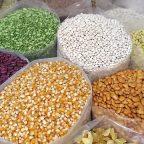
Are Beans Good For Diabetics?
Compared to other foods, beans are a food that normally does not receive a lot of appreciation. But because of their nutrient profile, low price, and positive environmental impact, they have quietly attained the title of superfood.
Additionally, a ton of research has shown how beneficial beans are for a variety of health conditions. But if you have diabetes, you might be asking if and how beans can be a part of your diet. Are beans healthy or bad for blood sugar levels? Now let us look.
What are beans?
Look in your pantry or cupboard; you may have some cans of chickpeas or kidney beans hidden there. Beans have a reputation for being a bit lower on the food chain and are frequently seen as a staple of the lower classes. They have been utilized as food since 9,000 years ago.
However, beans have always been thought to have unique abilities. Beans were placed in tombs by the ancient Egyptians as food for the dead as well as their spirits in the hereafter.
The United States is the “world leader in dry bean production,” according to The Bean Institute, and beans are now present in every culture. Every year, between 1.5 million and 1. 7 million acres of dry beans are planted by American farmers.
Beans are a member of the legume family, which also includes peas and lentils. According to the website aptly named Pulses, they are also known as “pulses,” the “edible seeds of plants in the legume family.” The seeds of several plant species are what we call beans.
Is it true that green beans, like black beans and kidney beans, are considered “beans”? No, as a matter of definition. Since green beans come in a pod, they are legumes rather than beans. We acknowledge that this is somewhat perplexing. But for this essay, the emphasis is on beans that are legumes and are not in a pod.
Types of beans
There are too many bean kinds to count, numbering in the hundreds. In different parts of the world, some varieties are more prevalent or well-liked. Here are some examples:
- Adzuki
A little, spherical, red bean with a seam down one side that is white. All around Asia are grown.
- Black bean
With a creamy texture, it is South and Central American native.
- Cannellini (white kidney bean)
Argentina-born, but highly well-liked in Italy. The beans feature a nutty flavor and a creamy texture.
- Fava bean (broad bean)
This bean, which is native to the Mediterranean region, grows in pods and can be consumed either fresh or cooked. They have a moderate, nutty flavor and are green in appearance.
- Garbanzo (chickpea)
The Middle East is the region of origin for this round, tan bean. The has a delicate nutty flavor.
- Kidney bean
A bean with the shape of a kidney and a moderate flavor.
- Mung
A little, round, green bean with a white stripe that is indigenous to India and Pakistan.
- Pinto
Originating in South America, this native has a moderate, slightly sweet flavor and is pink and brown.
Popular bean dishes
Despite the fact that you might not be enthusiastic about eating beans, it’s likely that you’ve already tried (and liked) foods that do, such as the following:
- Black bean soup
- Boston baked beans
- Hummus
- Refried beans
- Tuscan bean soup
- Navy bean soup
- Minestrone soup
- Red beans and rice
- Chili
- Cassoulet
A mainstay of vegetarian and vegan diets, beans have increased in popularity. There are recipes that employ beans in less “conventional” ways as well; some examples are black bean brownies, tortilla chips, bean smoothies, and Bolognese sauce made with beans rather than ground beef.
Do not be surprised if you browse the cereal section of your local grocery shop and discover that some cereals are manufactured with, you got it, beans!
Bean nutrition
Beans have a very amazing flavor, but their nutritional value is where they truly shine. Now let us examine what these legumes have to offer in more detail: –
Complex carbohydrate
Before you start to worry that beans are off-limits for people with diabetes, understand that the type of carbs present in beans are a combination of starch, resistant starch, nonstarch polysaccharides, and complex sugars known as oligosaccharides. These diverse carbohydrates are good for gut health and have low glycemic indexes, which means they are less likely to result in blood sugar increases.
Dietary fiber
Soluble and insoluble fibers can be found in beans. Blood cholesterol and blood sugar levels are reduced by soluble fiber. Colon cancer, diarrhea, and other digestive issues can all be avoided with insoluble fiber.
Protein
Since it can help you feel fuller for longer and may slow the digestion of carbohydrates, protein is a hot issue for people with diabetes. According to The Bean Institute, beans have a protein content of between 21% and 25% by weight. They are frequently utilized as a meat substitute because of this.
Vitamins and minerals
The majority of beans also contain magnesium, copper, iron, vitamin B6, riboflavin, thiamin, and folic acid in addition to potassium, which supports normal blood pressure.
Here is a breakdown of some of the most popular beans we typically consume in terms of their nutritional composition, displayed as a range.
Per 1 /2 cup serving:
- Calories: 110-125
- Carb: 19-24 grams
- Fiber: 5-1 O grams
- Protein: 6-9 grams
- Fat: 0.2-0.6 grams
- Sodium: 0-5 milligrams•
- Potassium: 305-502 milligrams
Beans and Diabetes
Beans are a healthy option for those who have diabetes, as was already mentioned. Beans’ soluble fiber is one of its main advantages. According to studies, consuming soluble fiber-rich foods in your diet will help reduce blood sugar and A1C levels.
Those with type 2 diabetes who consumed a cup of beans or lentils daily as part of a low-glycemic index diet were the focus of a study published in the Archives of Internal Medicine on October 22, 2012. Their A1C levels had decreased by 0.5 percentage points after three months.
According to a different study published in the journal Diabetes Care, soluble fiber reduces A1 C levels by roughly 0.6%.
What exactly is the mechanism of soluble fiber? In the digestive system, soluble fiber, commonly referred to as viscous fiber, gels up. Carbohydrate digestion is then slowed by the gel, which also inhibits glucose absorption. The outcome? decreases in A1C levels and blood sugars! Additionally, oats, apples, carrots, and barley are foods that are high in soluble fiber.
Speaking of soluble fiber, incorporating beans in your diet can also help lower LDL (“bad”) cholesterol. To stop cholesterol from being taken into the bloodstream, soluble fiber binds to it in the small intestine. Following that, the cholesterol is eliminated.
Beans can assist you in achieving your weight loss objectives, which can also benefit your blood sugar levels and cardiovascular health. As a result, you eat less because of their high fiber and protein content, which also helps to control your appetite.
You might be wondering, though, what about all those carbohydrates in beans? It is a good question, and the answer is that beans do contain carbohydrates. For the purpose of calculating carbs, a serving of beans is defined as 1/2 cup (or 1/3 cup for baked beans), which is “counted” as one carb choice and one lean protein choice.
The American Diabetes Association points out that 1/2 cup of beans “provides as much protein as an ounce of meat without the saturated fat.”
You can understand how beans and other meals affect your glucose levels by utilizing a blood sugar meter or CGM (continuous glucose monitoring).
Tips
- If all of this conversation about beans has made your mouth swim, fantastic! Here are some pointers to bear in mind:
- Take it easy on the beans if you aren’t used to consuming a lot of fiber. To reduce gassiness and bloating, increase your intake gradually.
- Beans in cans are quite cost-effective and convenient. They sometimes contain a lot of sodium, which is a drawback. Before eating the beans, either look for ones that have no salt added or give them a good rinse.
- Beans that have been dried can also be used. They must soak for at least eight hours or overnight. After that, you’ll have to cook them for 45 to 2 hours. View the directions here.
- When chopping, cooking, and prepping beans, an Instant Pot will save you a ton of time. It is possible to cook them after a quick soak in the saucepan for one minute (the time will vary based on the type of bean you use). Find out here how.
- To replace eggs in baked items if you do not consume them, use aquafaba, the liquid found in canned beans: Equivalent to one egg is three tablespoons of aquafaba. You can make meringue without using egg whites if you whisk aquafaba into firm peaks, too.
- There are numerous strategies to increase the amount of beans in your diet. Include them in any soups or stews you prepare. They can be added to salads as a garnish. When preparing meatballs or hamburgers, mix cooked beans with ground beef.
FAQs
Do beans raise your blood sugar?
Beans are a wonderful source of protein and fiber. Although beans include carbohydrates, they have a low glycemic index (GI) and do not significantly raise a person’s blood sugar levels. Beans are a type of complex carbohydrate.
Can diabetics eat beans and rice?
As long as it has been combined with beans, diabetic rice lovers can now savor white rice without concern. In a recent study, which was partially financed by the USDBC, researchers discovered that rice can cause blood sugar levels to rise, but beans, a healthy part of any diet, can prevent this from happening.
Can diabetics eat beans every day?
The final line is that, especially if you have diabetes, beans should be a staple in your diet. According to research in the journal JAMA, increasing one’s intake of beans, lentils, and other legumes can assist patients with type 2 diabetes to improve their glycemic control and reduce their risk of developing heart disease.
Are beans better than rice for diabetics?
Rice causes a substantially higher insulin response than beans, which are high in fiber and protein.
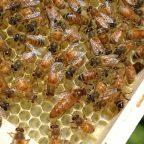
Propolis Benefits for Diabetes
Propolis Benefits for Diabetes
Honeybees produce propolis, a resinous or waxy compound. Multiple hues, including white, red, brown, and black, may be found in propolis. Because bees use it to construct their hives, it is often called “bee glue.” Similarly, bees utilize propolis to ward against parasites.
Beeswax and tree exudates are blended with the bees’ saliva. Propolis is made from the resin of various plants, flowers, and trees; thus, its exact makeup, color, and qualities will change depending on where you live. However, propolis’s health advantages are shared by all of its varieties.
The Greeks, Egyptians, and Assyrians used propolis for various medical treatments. Wounds, stomachaches, and sore throats are just a few conditions it may treat.
Furthermore, it has potential pharmaceutical use due to its anti-inflammatory and anti-cancer characteristics. Propolis is effective against several microorganisms, including bacteria, fungi, and protozoa. Propolis may be applied to the skin, taken orally, or used as a mouthwash.
Propolis composition:
- Resin 50g
- Wax 30g
- Essential oils 10g
- Organic compounds 10g
Amino acids, carbohydrates, minerals, vitamins, antioxidants, and bioactive chemicals are all examples of the organic substances found in propolis. Vitamins B1, B2, B6, C, and E may be found in this.
This includes bioactive chemicals, including flavonoids, polyphenols, and organic acids. Magnesium, copper, zinc, manganese, and iron may all be found here.
Propolis Health Benefits for Blood Glucose Control
Keeping your blood sugar in check is crucial to your overall health. Diseases like diabetes, however, make it impossible to regulate blood sugar. The damage from free radicals, or oxidative stress, worsens these problems.
It has been shown that consuming propolis may help control blood sugar levels and lessen oxidative stress’s negative effects on various body systems. This is due to the high levels of antioxidants (including vitamin C) found in propolis.
Antioxidants neutralize harmful free radicals and considerably mitigate oxidative stress. As a result, it prevents harm to the internal organs. Also, it helps avoid the onset of several persistent diseases, including diabetes.
Propolis has been shown to improve diabetes in a scientific investigation. Propolis consumption for 90 days resulted in lower blood sugar and higher insulin. Our bodies manufacture the hormone insulin to help control blood sugar levels. Many people with diabetes suffer from a lack of control over insulin production. Giving them a daily dose of propolis may help.
Intestinal absorption of sugars and starches is reduced by propolis. This has the effect of lowering blood sugar levels rather than raising them. Hence, it may help those with diabetes and high blood sugar levels.
As a bonus, propolis improves the organs’ ability to absorb glucose from the blood. It lowers blood sugar levels and nourishes and energizes organs simultaneously.
Propolis Health Benefits for the Lungs and Kidneys
The use of propolis has been linked to enhanced lung function and health. Antioxidants are plentiful in propolis, as was previously noted. They protect various tissues and organs from damage caused by free radicals. As a bonus, it helps keep lung cells healthy and reduces inflammation.
The amount of inflammatory cells in the lung alveoli is reduced by propolis, too. The protective effects of propolis against tobacco smoke and related lung illnesses have been the subject of at least one investigation.
The kidneys are also targets of propolis’s same mechanism—this aids in protecting the kidney from oxidative damage and inflammation. According to recent research results, it may help stave against chronic kidney disease. The flavonoid chrysin in propolis also protects the kidney’s structures from damage and aids in reducing renal injury.
Podocytes, kidney cells, are other cells that propolis helps shield against apoptosis. High blood glucose levels may prevent kidney cells from filtering out the sugar. Instead, it causes injury and, in some cases, death.
Benefits Cardiovascular Health
A study at the University of Plymouth found that propolis effectively lowered blood pressure. This is due to the fact that propolis has been shown to increase levels of beneficial bacteria in the oral cavity.
These microorganisms aid in the conversion of dietary nitrates to nitrite. As a chemical, nitrite can dilate blood arteries, allowing more room for blood to circulate and thereby reducing blood pressure. Those with hypertension (high blood pressure) may benefit from taking propolis.
Cholesterol levels may be lowered with the aid of propolis as well. The heart may be made healthy by reducing blood pressure and cholesterol levels. In addition, it helps protect against atherosclerosis, congenital heart defects, coronary artery disease, and other chronic heart conditions.
Propolis Controls Cholesterol
Antioxidants in propolis protect tissues and organs from damage caused by free radicals. Antioxidants may help lower total cholesterol and “bad” LDL cholesterol levels.
The levels of both “bad” (LDL) and “good” (HDL) cholesterol may be lowered and raised, respectively, by taking propolis extracts, as shown in recent research. They help keep the arteries free of cholesterol buildup and plaque.
Thus, it aids in warding off various cardiovascular conditions, including atherosclerosis, hypertension, and even heart attacks. Consuming regularly may help ward against a wide range of potentially fatal illnesses.
Anti-inflammatory Properties
There is evidence that propolis may help reduce inflammation in the body. Diseases including diabetes, heart disease, and arthritis have all been inflammation-related. It also aids with wound healing, which is a nice bonus. That’s why eating propolis is a great way to lessen general inflammation:
Propolis flavonoids can control inflammatory enzymes. Reduced levels of these enzymes and factors lead to less inflammation. Another mechanism by which propolis inhibits inflammation is by blocking macrophages’ synthesis of nitric oxide and cytokinin.
Inflammation is a common side effect of macrophages. Therefore, propolis decreases inflammation in the body by hindering the efficiency of macrophages.
Commercially accessible propolis nasal sprays are out there. The use of these sprays may mitigate sinus irritation. Additionally, they help alleviate the signs of a cold or flu.
Capacity to Heal Wounds
To speed up the recovery process, propolis is applied to the wound. Antioxidants in propolis, such as polyphenols, can mitigate the harm from free radicals. Therefore, it protects cells in various bodily systems from injury.
This quality also aids in wound healing and hastens the process. For instance, many over-the-counter cold sore treatments include propolis at a concentration of 3% to speed healing and forestall further outbreaks.
Researchers have found that propolis may help burns recover. Numerous bioactive chemicals found in propolis aid in cell division. In other words, it promotes the production of new cells and tissues. As a result, it may hasten the process of healing cuts and scrapes.
The anti-inflammatory qualities of propolis also help wounds heal more quickly. The body’s inflammatory reaction to wounds and germs. It has the potential to impede healing and aggravate wounds, though. The healing process for wounds is aided by decreasing inflammation.
In addition, propolis’s antimicrobial characteristics hasten the recovery from wounds. Bacteria and fungi are the most common infectious microorganisms. Therefore, decreasing the number of organisms in the wounds helps hasten their healing.
Antimicrobial Properties
The antibacterial qualities of propolis have made it famous. Properties against bacteria, fungi, viruses, and protozoa are included. According to single research, Propolis has been shown to be effective against various bacteria, including Streptococcus, Staphylococcus, Escherichia coli, and Helicobacter pylori.
Infections caused by these bacteria range from those that manifest on the skin to those in the intestines. In particular, Helicobacter pylori may lead to infections and ulcers in the stomach.
Bioactive chemicals, such as flavonoids, propolis its antibacterial capabilities. Pinocembrin, a flavonoid, has been shown to inhibit bacterial DNA synthesis and disrupt bacterial energy metabolism. So it may put a halt to their development and offspring creation.
Evidence shows they are effective against other viruses, such as the Herpes virus, HIV, influenza, and COVID-19. Chrysin is a flavonoid that inhibits viral replication or virus generation.
Possible Propolis Adverse Effects
People sensitive to bee products may have adverse responses when exposed to propolis. Knowing what triggers an allergic reaction is, thus, essential. Consuming an excessive amount of propolis may cause oral irritation and ulcers. Propolis contains chemical ingredients that may prevent excessive blood clotting. People with bleeding disorders or who have recently had surgery should not use it. And it’s best to see a doctor before consuming propolis.
How to Use Propolis Most Effectively
A daily dose of 400–500 mg of propolis is suggested. Propolis may be taken orally as a dietary supplement or diluted with water. Propolis is also used in several topical treatments, such as cosmetics, mouthwashes, and ointments.
Final Thoughts
Bees produce a natural substance known as propolis. Propolis contains beneficial nutrients such as vitamins, minerals, antioxidants, and bioactive substances. Propolis also has anti-inflammatory and antioxidant properties.
This has the potential to improve the condition of the heart, lungs, and kidneys. Also, it can reduce our blood pressure and cholesterol levels, two risk factors for many types of chronic illnesses. More study is needed to understand its mechanism and efficacy.
FAQ
Is propolis good for diabetes?
Recently, studies have shown that propolis results in a lowering of blood glucose levels, serum insulin levels, serum glycosylated hemoglobin (HbA1c) levels, with improvement, for type 2 diabetics of insulin resistance
Can diabetics eat propolis?
Yes, in very limited amounts.
Can propolis cause a rise in blood pressure?
Extracts of propolis and pollen, made by bees, effectively control hypertension when taken in ethanolic form. It has been hypothesized that propolis and pollen may assist in controlling reproductive function by blocking the inflammatory processes that cause hypertension.
Can propolis assist in losing weight?
One of the primary components of propolis, caffeic acid phenethyl ester, prevents high-fat diet-induced adipogenesis through modulating cyclin D. Researchers have shown that the composition of human gut microbiota changes in response to food types and calories consumed.
Can we call propolis a “probiotic?”
Propolis may serve as a prebiotic at low quantities, but at greater concentrations, it may impair the probiotics’ planktonic development and biofilm-forming abilities.
Is there a need to keep propolis in the fridge?
Propolis can be kept at room temperature, but if you only need a small quantity, you can keep it in the fridge or freezer and break it up into tiny pieces on a cutting board or with a big spoon to use.
Are there those who shouldn’t take propolis?
Those with a bleeding issue may be at a higher risk of bleeding if they take propolis. Sensitivity: Bee venom has the potential to taint several propolis products. If you have an allergy to bee stings or other bee-related items, use care while using propolis. Surgery. Propolis contains a substance that may prevent blood clots from forming.
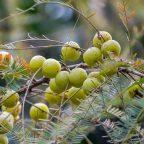
Medicinal Uses of Amla (Indian Gooseberry) for Diabetics
Medicinal Uses of Amla (Indian Gooseberry) for Diabetics
Phyllanthus Emblica, often known as Amla or Indian gooseberry, is a medium-sized tree native to India that bears a firm, spherical, greenish-yellow fruit. Indians use Amla extensively in the kitchen, and it also has several Ayurvedic applications.
However, does Amla help with diabetes?
Amla has well recognized as an excellent cure for diabetes thanks to its capacity to strengthen the immune system. With this essay, we are closer to answering the question of whether or not Amla is beneficial for diabetics. I
n people with diabetes, the B cells in the Isle of Langerhans in the pancreas produce inadequate amounts of the hormone insulin, leading to dangerously high blood sugar levels. Insulin is a hormone that facilitates the digestion of sugar and glucose absorption by cells from the blood.
Type 2 diabetes, or Diabetes Mellitus, is a metabolic condition characterized by high blood glucose levels due to insulin resistance. People with diabetes must watch their caloric intake, and meals rich in fructose or starch are harmful to their condition.
However, numerous foods, including Amla, have been shown to aid with diabetic management. Amin is beneficial for those with both type 1 and type 2 diabetes.
Amla has several health benefits.
Amla is a popular plant in traditional Ayurvedic medicine because of its powerful anti-aging, anti-diabetic, and kidney-protecting properties.
Heartburn caused by indigestion may be alleviated by using Amla juice or extracts. Because it aids in digestion and lessens gastrointestinal troubles caused by indigestion, dried Amia makes for a great snack after a big meal.
It has been shown via scientific research that amla has anti-aging properties that are advantageous. Amla promotes the regeneration of cells and aids in the healing of wounds. Amla prevents collagen, the protein matrix of the skin, from degrading, which helps to maintain the skin’s youthful appearance and elasticity. Because it strengthens the follicles of the hair, amla is also good for the eyes and the hair.
A high concentration of antioxidants may be found in Amla. When it comes to curing malignant cells, antioxidants are crucial. It has been shown that Amla extracts aid in the recovery of malignant cells.
Antioxidants like Vitamin C also aid in lowering blood pressure, which is beneficial for your heart. It reduces triglyceride, total cholesterol, and LDL (bad) cholesterol while raising HDL (good) cholesterol levels, which aids in normalizing fat and blood glucose levels. Diabetics may benefit from drinking amla juice.
Amla prevents blood from clotting and the buildup of plaque in arteries by reducing blood viscosity. Because of this, there is a decreased possibility of having a heart attack caused by the obstruction of arteries.
The use of amla juice may be beneficial for diabetics. Amla juice is a delicious and healthy option for diabetics because to the high level of antioxidants it contains.
Amla’s Diabetes-Friendly Benefits
Amis promotes insulin secretion and speeds recovery from pancreatitis. The advantages of Amla may also be extracted from Amla candies; however, fresh Amlas are always preferable. Reduces the concentration of sorbitol, a harmful sugar that contributes to an already high risk of diabetes sequelae, including retinopathy and neuropathy.
- Improves insulin sensitivity and glycemic control.
- It betters the body’s ability to handle glucose.
- Reduces HbA1c in those with Type 2 Diabetes.
- The control of glucose metabolism
- It enhances how the body responds to insulin.
- The involvement of Amla in enzyme activity is substantial.
- Lowering triglyceride levels in the blood
- Elevate both HDL and LDL Synthesis
To what extent does Amla aid in glycemic management?
Amla promotes pancreatic repair, boosts insulin release, and improves cell sensitivity to insulin absorption.
Type 2 diabetics may benefit from the antioxidant qualities of Amla since it aids in glucose metabolism and lowers the body’s blood glucose levels.
Amla helps persons with type II diabetes because it reduces the buildup of toxins in the body.
In addition to its other benefits, Amis aids in reducing body fat and restoring a healthy fat-to-blood ratio.
Amla with Diabetes: Several Dosages and Preparations
You may drink amla juice or consume raw fruit. Although raw Amla is ideal, its strong sourness may put off certain consumers.
To make a delicious snack, cut open a raw amla, remove the seeds, and sprinkle with rock salt. However, those who already have hypertension should limit their salt consumption.
You may get Amla in powder or pure juice and drink it daily with water. Amla juice or raw amlas, used regularly, has been shown to reduce fluctuations in blood sugar levels significantly. Amla candy is beneficial for persons with diabetes since it maintains steady blood sugar levels without sacrificing taste.
Because it has a high concentration of antioxidants and vitamin C, amla murabba may be helpful in regulating blood sugar levels. In addition to this, taking amla murabba might cause an increase in the acidity of the stomach; as a result, there are some unexpected effects.
Because Amla murabba has not been the subject of substantial research, it is suggested that you see a nutritionist prior to purchasing any of it.
Conclusion
Amla has been revered in Ayurveda for its many uses since ancient times. Everyone, particularly diabetics, may benefit from adding more fresh Amla to their diet. The article explains how Amla may help with anything from weight loss to strengthening your immune system. Amla contains anti-diabetic qualities, including the ability to lower high blood glucose levels and the prevention of toxic buildup in the body.
Type 1 and Type 2 diabetics may benefit from Amla’s use since the herb has been shown to have several positive effects on both conditions.
FAQ
Does Amla lower blood sugar levels?
Amla is a traditional medicine that has been shown to reduce post-meal blood sugar crashes. Amla, also known as Indian gooseberry, is often advised by medical professionals as a general tonic and topical therapy for skin, hair, and other disorders.
Does Amla have a lot of sugar?
Amla, on the contrary, has no sugar and boasts a whopping 500–800 milligrams (mg) of vitamin C per Amla. Amla has many health benefits for everyone, but those with diabetes will see the most dramatic changes from eating it.
At what dose should A diabetic take amla?
Depending on how severe their diabetes is, an individual may consume either one or two Amla daily. Raw or juiced, the fruit is delicious. Amla is a fantastic natural alternative to insulin for maintaining healthy blood sugar levels.
Amla for diabetes: how to use it?
If you find the sourness of a single Amla a day too much to bear, you may always chase it with a glass of water. This is the most effective approach to utilizing Amla for diabetes management. Amla powder is another form in which the fruit may be consumed. You may add lime juice or water to this.
Can insulin resistance be reduced by taking amla?
One research found that Amla helped reduce blood sugar levels. In addition, it improves glucose metabolism, reduces blood sugar, and prevents the accumulation of toxins in the body. Furthermore, its high antioxidant content helps alleviate diabetic symptoms by lowering insulin resistance in cells.
To what extent can Amla help with diabetes?
Diabetic-fighting Amla. It enhances glucose metabolism, lowers sugar levels, and stops the buildup of toxins in the body. In addition to alleviating diabetic symptoms, its high antioxidant content also reduces insulin resistance in cells.
Can amla and turmeric help diabetics?
A morning drink that includes a sprinkle of turmeric and two tablespoons of gooseberry (Amla) juice is also recommended. According to studies, persons with diabetes who consume gooseberry saw significant improvements in their cholesterol levels.
Are there any repercussions for the liver if you consume Amla?
The effects of amia on liver function, hyperlipidemia, and metabolic syndrome have all been documented to be positive. Experimental animal models have shown that Amia may prevent chemical-induced hepatocarcinogenesis.
Amla and metformin: friends or foes?
Alternatively, compared to Metformin alone, the combination of Metformin and Amla was considerably more effective in lowering blood glucose levels. When given together, the medications boosted the animals’ weight, even though the diabetic animals were already obese, to begin with.
Medicinal plant Amla’s pharmacodynamic interactions with Metformin increased the diabetes drug’s hypoglycemic efficacy.
Will Amla help my pancreas?
Amla, an Ayurvedic herb, stimulates extracellular signal-regulated kinase and promotes apoptosis in pancreatic cancer cells.
Exactly what is Amla’s downside?
Some persons with allergies may see an increase in bleeding after consuming Amla products. Amla should be taken with care by people with diabetes since it can potentially cause dangerously low blood sugar levels. Skin dryness may occur if too much Amla juice is consumed.
Disclaimer Please consult a qualified medical expert for any health-related questions since the content provided here is for informational purposes only. Given that each individual is unique, it is ultimately up to the reader’s physician or another healthcare provider to assess whether the advice given here is appropriate for them.
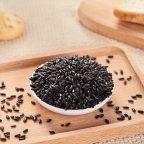
Black Rice Benefits for Diabetes
Therapeutic Value of Black Rice for Diabetics
Blood sugar levels are more stable after eating black rice.
The high fiber content helps you feel satisfied for longer and cuts down on snacking.
Black rice’s anthocyanins assist people with diabetes in combating inflammation and free radicals. The oxidative stress brought on by hyperglycemia is mitigated by its antioxidant capabilities.
The fast growth of the world economy has coincided with an increase in the prevalence of diabetes, which has been linked to bad lifestyle choices, including poor nutrition and insufficient physical activity.
However, hyperglycemia may very readily induce systemic vascular damage, which in turn can lead to a wide range of chronic issues that pose a significant risk to the patient’s life and well-being.
Black rice, also known as forbidden rice and purple rice, comes from the Oryza sativa L. variety of rice. The pigment anthocyanin is responsible for the distinctive black-purple hue of black rice; it also happens to be a powerful antioxidant.
Black rice was supposedly so rare and valuable in ancient China that only the emperor was allowed to eat it.
Black rice is now commonly used around the globe as a staple food due to its mild, nutty taste, chewy texture, and several health advantages:
- A rich source of several essential elements.
- Black rice has one of the highest protein concentrations of any rice variety.
- Black rice has grams of protein in 3.5 ounces (100 grams), but brown rice only has 7 grams.
- It’s rich in iron, a mineral needed to transport oxygen throughout the body.
Black rice gives in a quarter cup (45 grams) when uncooked:
- In terms of calories, the answer is 160.
- 1.5 g Fat
- Four grams of protein
- Net carbs, 34 grams
- One gram of fiber
- Includes 6% of the DV for Iron (DV)
- Reduce your blood sugar level
There’s some evidence from animal research that consuming black rice and other anthocyanin-containing foods may help control blood sugar in people with type 2 diabetes.
Protects against the development of Type 2 diabetes
In other words, you can still consume black rice even if you don’t have this disease. Its rich fiber and protein content may help prevent diabetes by keeping blood sugar steady.
Highly antioxidant
Black rice is rich in numerous antioxidants and is a strong protein, fiber, and iron source.
Compounds called antioxidants shield cells from damage caused by free radicals.
Their significance lies in that oxidative stress has been linked to an elevated risk of various chronic diseases and disorders.
Black rice has the greatest total antioxidant capacity and activity, although it is not as widely consumed as other types of rice.
Over twenty-three antioxidant-rich plant components, including many flavonoids and carotenoids, have been identified in black rice.
Therefore, eating black rice may be a simple method to increase your intake of these disease-preventing antioxidants.
Anthocyanin, a plant pigment, is present.
The flavonoid plant pigments known as anthocyanins give foods like black nice and blueberries and purple sweet potatoes their distinctive purple hues.
Extensive scientific investigation has shown that anthocyanins possess potent anti-inflammatory, antioxidant, and anticancer properties.
Eating foods rich in anthocyanins have also been linked to a reduced risk of developing various chronic illnesses such as heart disease, obesity, and some types of cancer, according to a number of studies conducted on animals, test tubes, and human populations.
Potential benefit to cardiovascular health
There is a shortage of data about black rice’s influence on cardiovascular wellness. However, several studies have shown that many of its antioxidants may reduce the risk of cardiovascular disease.
Black rice’s flavonoids have been linked to a lower chance of developing and dying from heart disease. As an added bonus, preliminary animal and human studies on anthocyanins show they may aid in lowering cholesterol and triglyceride levels.
Cholesterol and triglyceride levels
Taking two 80-mg anthocyanin capsules daily for 12 weeks considerably raised HDL (good) cholesterol levels and dramatically lowered LDL (bad) cholesterol levels, according to a study of 120 persons with high cholesterol levels.
Plaque formation in rabbits fed a high-cholesterol diet was reduced by half when black rice was included in the diet, compared to diets fed the same amount of cholesterol but made primarily of white rice.
Although this research hints that black rice may protect against heart disease, no such findings have been shown in people.
Possible benefits to eye health
High levels of the carotenoids lutein and zeaxanthin, both of which have been linked to improved eye health, have been found in black rice.
As antioxidants, these molecules help shield your eyes from harmful free radicals.
In particular, the antioxidants lutein and zeaxanthin have been demonstrated to shield the retina from damage caused by blue light.
Recent studies have shown that these antioxidants may play a significant role in preventing age-related macular degeneration.
The disease of age-related macular degeneration (AMD) is the main cause of blindness around the globe. Cataracts and diabetic retinopathy are two more eye conditions that might be helped by wearing them.
Finally, anthocyanin extract from black rice reduced the amount of retinal damage caused by fluorescent lights in mice in research lasting just a week. However, this research has not been confirmed in human subjects.
Gluten-free by nature
Cereal grains, including wheat, rye, and barley, contain a protein called gluten.
Gluten is avoided by those who have celiac disease because it sets off an immunological reaction that destroys the small intestine.
Additionally, those who are gluten intolerant may get unpleasant gastrointestinal symptoms from consuming Glen, including bloating and abdominal discomfort.
Black rice is a healthy alternative for individuals who must avoid gluten but still want the benefits of a whole grain.
Weight loss benefits
Both the protein and fiber in black rice are beneficial for weight reduction since they make you feel full faster and curb your appetite.
Anthocyanins, such as those in black rice, have shown promise in preliminary animal studies for lowering fat and overall body mass.
After receiving anthocyanins from black rice, obese mice on a high-fat diet saw a 9.6 percent decrease in body weight after 12 weeks. The same findings have yet to be shown in human studies.
Despite this, there is a shortage of studies examining black nice’s effect on human weight reduction. In conjunction with brown rice, it has been shown to aid in weight loss.
Methods of Eating Black Rice for Diabetics
Both black and white rice may be prepared and eaten in the same manner. Black good, on the other hand, needs a little more time in the oven.
Swap out white rice for black and have it with dal and curry.
Create veggie-filled black rice bowls with your go-to ingredients.
Noodles and cakes made from black rice are also possible.
Optimal Timing for Eating Black Rice
The morning and afternoon are the optimal times to eat black rice for diabetes. Eating black rice in the evening might cause bloating and indigestion because of how slowly it is digested.
The Dangers of Consuming Excessive Amounts of Black Rice
Patients with diabetes should monitor their intake of black rice to prevent gastrointestinal issues like gas and indigestion from occurring. Discomfort in the digestive tract and bloating. Black rice has a high fiber level, which makes it hard to digest. For this reason, you should never eat too much black rice at once.
While black rice may be a healthy supplement to a diabetic diet, the recommended daily intake will vary from person to person. Black rice is healthy, but it’s important to talk to your doctor about how much you should eat.
Conclusion
People with diabetes may benefit greatly from consuming black rice.
Although less prevalent than other varieties, black rice has the greatest antioxidant activity and more protein than brown rice.
Therefore, it’s possible that consuming it might improve eye and heart health, protect against certain types of cancer, facilitate weight reduction, and more.
Even though it’s a healthy grain, black rice has many more benefits. The rich purple hue it takes on when cooked makes even the simplest dish seem fancy.
Combine black rice with other low Gl meals, protein sources, and healthy fats to maintain appropriate blood sugar levels.
FAQ
Should people with diabetes eat black rice?
Black rice, which has a glycemic index of just 42, 3, is packed with healthy nutrients and a low-glycemic profile. Since it’s high in beneficial nutrients like fiber, protein, antioxidants, and minerals, it may be included in a diabetes-friendly meal plan.
Does eating black rice have an effect on blood sugar?
Additional advantages of black rice include: Bringing down your blood sugar Research on animals suggests that people with type 2 diabetes who consume foods rich in the antioxidant anthocyanin may see improvements in their blood sugar levels.
A lower glycemic index is associated with black rice. Therefore, black rice is the best option for diabetes, high blood sugar, or insulin sensitivity.
Is there a limit to how often you may have black rice?
Black rice’s high fiber content means it’s OK to consume every day. Fiber and nutrients in black rice dally are more important to weight loss than fat or cholesterol. For grownups, it’s also a useful source of sustained vitality.
Is there a lot of carbs in black rice?
A vegan and gluten-free side dish that packs a tremendous nutritional punch: Nice! Black rice is the healthiest option available, with more protein and less carbohydrates and calories than any other kind of rice.
When it comes to insulin resistance, can black rice help?
Because of its high fiber content, black rice prevents you from eating too much. Further, studies have shown that eating black rice may help reduce insulin sensitivity, which in turn may reduce the risk of obesity.
When it comes to kidney health, is black rice a healthy option?
Black rice protects the liver and kidneys from harm because of its antioxidant and anti-inflammatory characteristics.
What is the black rice sugar content?
Black rice has a total of 0g of sugar; therefore, all its carbohydrate content comes from starch.
Is black rice superior to red rice?
Similar to how red rice looks. The pigments known as anthocyanins give it its blue hue. However, studies demonstrate that black rice outperforms all other types in terms of antioxidant action. These include protection against cardiovascular disease, cancer, and other long-term illnesses.
Is it true that black rice reduces inflammation?
Due to the presence of anti-inflammatory chemicals, black nice has been widely lauded for the various ways in which it benefits human health.
Is there any effect on the glycemic index when vinegar is added to rice?
Rice with vinegar serves several purposes: The rice gets its flavor from the vinegar. When added to rice, vinegar keeps the grains from clumping together. 3 To lower the starch’s glycemic load, vinegar may be added to rice (and other starches).
Can cholesterol levels be lowered by eating black rice?
Eating black rice may help lower blood cholesterol levels. This compound stifles the enzymes in your body that create cholesterol. In addition, it aids in the process of losing weight. When combined with other low-fat, healthy components, black rice may aid in weight reduction.
In what way should a diabetic patient prepare rice?
- Add 1.5 cups of water for every cup of brown rice to a saucepan and bring to a boil.
- In a covered saucepan, bring water and rice to a boil.
- Simmer for approximately 20 minutes with the lid on.
- Remove the saucepan from the heat and let it cover for 10 minutes.

Broccoli Sprout Extract Improves Blood Sugar
Broccoli Sprout Extract Lowers Blood Sugar
Broccoli is a member of the cruciferous plant family, and its many health advantages have long been recognized partly because of its sulfur-containing chemicals.
The fasting blood sugar levels of obese persons with type 2 diabetes significantly improved after consuming a chemical contained in broccoli sprouts and other cruciferous vegetables.
It was also discovered that the substance, known as Sulforaphane, decreased glucose production in cultured liver cells and seemed to correct aberrant gene expression in the livers of rats.
The research by Annika Axelsson and coworkers at the Lund University Diabetes Center in Sweden was published in the journal Science Translational Medicine.
Among the many positive effects of broccoli sulforaphane:
The risk of developing cancer is lowered by minimizing exposure to carcinogens and bypassing the body of these substances.
Removal of toxins from the liver (VIP: the active sulforaphane selective phase 2 detoxifying enzyme inducers without triggering the phase 1 enzyme induction, for example, c, cytochrome P450). The potential of anti-carcinogens to stimulate the production of phase 2 enzymes has been shown as a key characteristic of these substances.
- Promote a healthy inflammatory response by stimulating the production of anti-inflammatory, antioxidant enzymes.
- Enhances Glutathione, the predominant intracellular antioxidant
- It gives DNA a chance to defend and repair itself
- Maintenance of an optimal amount of the ulcer-causing H. pylori bacterium ( it is needed to a certain extent but not to the point where it causes stomach ulcers )
Type 2 Diabetes
About 90–95% of all instances of diabetes are classified as type 2, making it the most prevalent form of the disease.
A lack of proper insulin use leads to excessive blood glucose levels and the onset of this disease. Severe consequences, such as heart attack, stroke, nerve damage, and renal failure, may develop in people with type 2 diabetes if their blood glucose levels are not managed.
Although treatments like metformin may help persons with type 2 diabetes regulate their blood glucose levels, Axelsson and colleagues point out that some patients use these drugs owing to significant side effects such as kidney damage.
Therefore, more secure options are needed. Has Sulforaphane the potential to fill this void?
Liver gene expression and blood sugar were both increased by Sulforaphane. Axelsson and colleagues sought to address this topic by developing a genetic signature for type 2 diabetes based on the 50 risk factors previously identified.
Using this signature, the scientists analyzed freely available gene expression data. By doing so, they evaluated the impact of over 3,800 chemicals on the changes in gene expression in liver cells related to type 2 diabetes.
Sulforaphane, a chemical molecule found in cruciferous vegetables, including broccoli sprouts, Brussels sprouts, cabbage, and watercress, was shown to have the most impact, according to the study’s authors. Sulforaphane inhibited glucose synthesis in cultured liver cells. It was shown that when this chemical compound was given to diabetic rats, the liver’s gene expression changed for the better.
Following this, the team conducted a 12-week, randomized, controlled trial of broccoli sprout extract in 97 people who were overweight. A placebo-controlled trial means exactly what it says. Everyone in the adult population had been diagnosed with type 2 diabetes and had poor glucose control.
Fasting blood glucose levels were significantly lower in those who took the broccoli sprout extract than those who did not. Additional studies are required to establish if Sulforaphane helps people with type 2 diabetes, although the results of this one are encouraging.
They are using genetic fingerprints to examine public gene expression data, as Axelsson and colleagues have done, which may be an efficient approach to finding chemicals that might aid in treating diabetes and other disorders.
Frequently Asked Questions
What are the benefits of broccoli sprout extract?
Broccoli sprout extracts reduce glucose levels in the blood. It has been shown in vitro and animal tests that a compound in broccoli sprouts may increase the body’s sensitivity to the hormone insulin, lowering blood sugar—improving articular health.
Do broccoli sprouts help lower estrogen levels?
Sulforaphane levels in broccoli sprouts are 30–100 times higher than in mature broccoli. Sulforaphane’s three incredible effects make it a game-changer: It acts as a natural ” estrogen blocker ” by binding to estrogen receptors and preventing the growth of malignant tissue caused by “bad” estrogens, such as in the case of breast cancer.
What does Sulforaphane do?
Sulforaphane inhibits the growth of cancer cells. That’s significant because it suggests it may make tumors grow more slowly or prevent them from spreading. It’s easy to get your hands on. You don’t have to do anything to gain the health benefits of Sulforaphane found in cruciferous vegetables.
Can Sulforaphane assist in liver detoxification?
By stimulating the production of liver enzymes that break down dangerous toxins, Sulforaphane facilitates the body’s natural detoxification processes and speeds up the disposal of these toxins.
Can Sulforaphane boost testosterone levels?
Type 2 diabetes has been linked to low testosterone levels. In men, Sulforaphane has been shown to boost testosterone.
To what extent does Sulforaphane benefit the kidneys?
Sulforaphane is effective in treating kidney illness by targeting the Nrf2 pathway.
Is there any truth to the claim that eating broccoli may reduce blood sugar levels?
Broccoli is considered a low-glycemic food since it does not significantly increase blood sugar levels after consumption. The Glycemic Index of broccoli is just 15, making it a good choice for those trying to control their blood sugar.
Do sprouts help to lower blood sugar?
However, since their starch content is reduced by 10% during the sprouting process, these foods are low in carbohydrates. As a bonus, they prevent a surge in blood sugar since they contain plenty of fiber. These two factors justify including sprouts in a diet for people with diabetes.
So, how exactly does one take in Sulforaphane?
Cruciferous plants, including broccoli, kale, cabbage, and watercress, are good sources of Sulforaphane. If you want to get the most Sulforaphane out of your diet, try eating raw veggies or cooking them at moderate temperatures with a dash of mustard seeds or powder.
When will I start to feel the effects of Sulforaphane?
Sulforaphane is usually effective within 14 days of treatment.
Will my blood pressure increase with Sulforaphane?
Reduced blood pressure and eradication of cardiac dysfunctions, including cardiac hypertrophy and decreased fractional shortening, are the outcomes of Nrf2 activation produced by Sulforaphane.
Will Sulforaphane cause drowsiness?
Since Sulforaphane boosts melatonin synthesis, it might lead to better sleep. Sulforaphane reduces the inflammatory compound prostaglandin D2. Sulforaphane’s melatonin and anti-inflammatory effects could make it easier to go to sleep.
Have any adverse reactions been reported with Sulforaphane?
At high dosages, Sulforaphane caused significant drowsiness (150-300 mg/kg) and hypothermia (150-300 mg/kg). Deaths (at 200-300 mg/kg), impaired motor coordination (at 200-300 mg/kg), and a loss in skeletal and muscular strength (at 250-300 mg/kg).




